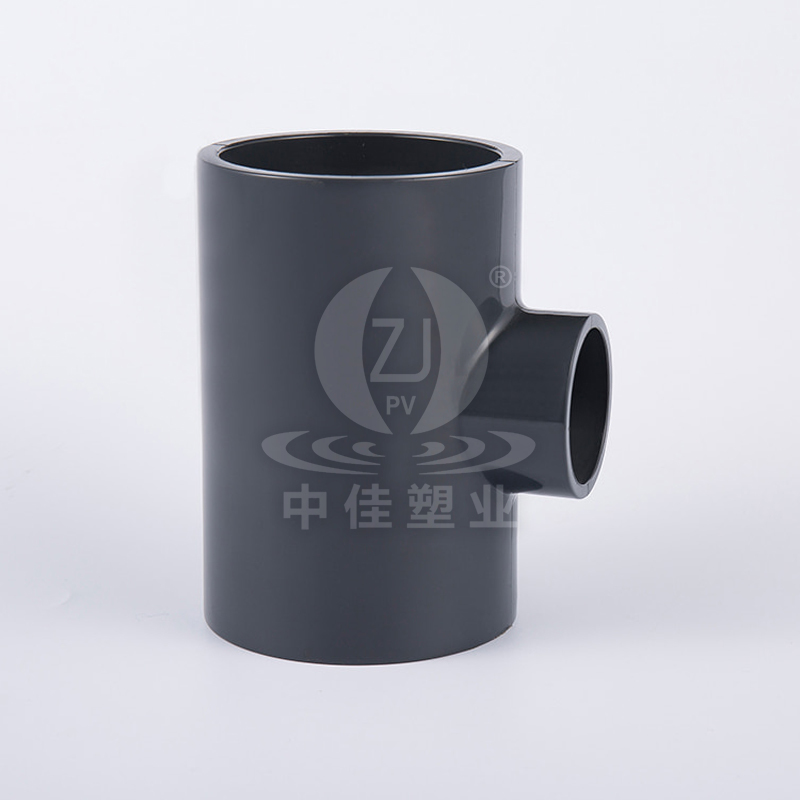In plumbing and industrial piping systems, fittings play a crucial role in ensuring smooth flow, system integrity, and operational efficiency. One such essential fitting is the UPVC reducing tee. But what exactly is a UPVC reducing tee, why is it widely used, and how does it improve your piping system’s performance? This article explores the features, applications, advantages, and installation considerations of UPVC reducing tees.
1. What Is a UPVC Reducing Tee?
A UPVC reducing tee is a three-way pipe fitting made from unplasticized polyvinyl chloride (UPVC) that connects three pipes of different diameters. The design allows fluid or gas to flow from one main pipe into two smaller branches, or vice versa, with minimal turbulence. The term “reducing” refers to the fact that the branch or one of the outlets is smaller than the main pipe, allowing for a seamless reduction in pipe diameter while maintaining system efficiency.
UPVC is widely chosen for such fittings due to its corrosion resistance, lightweight nature, and chemical stability, making it suitable for both industrial and residential applications.
2. How Does a UPVC Reducing Tee Work?
A reducing tee functions as a branching and reducing junction in a piping network:
- Fluid Entry – The fluid enters the main pipe at a steady flow.
- Branching – At the tee junction, the flow splits into two directions, one continuing along the main pipe and the other directed through the reduced-diameter branch.
- Flow Reduction – The branch pipe’s smaller diameter naturally reduces flow rate while maintaining pressure in the system.
- Efficient Distribution – The smooth internal surface of UPVC ensures minimal turbulence and pressure loss at the junction.
This design ensures that fluid distribution is controlled, allowing for precise flow management in complex piping systems.
3. Key Features and Advantages of UPVC Reducing Tee
| Feature |
Description |
Benefit |
| Material Strength |
Made from unplasticized PVC |
Durable, corrosion-resistant, and long-lasting |
| Chemical Resistance |
Resistant to acids, alkalis, and salts |
Ideal for chemical processing and industrial piping |
| Lightweight |
Easier to handle and install compared to metal fittings |
Reduces labor costs and installation time |
| Smooth Interior Surface |
Reduces friction and prevents blockage |
Ensures efficient fluid flow |
| Multiple Sizes |
Available in various diameters and reducing combinations |
Flexible for different system requirements |
| UV and Weather Resistance |
Suitable for outdoor installations |
Maintains integrity in harsh environments |
| Easy Installation |
Can be solvent-welded or threaded |
Simplifies piping connections and maintenance |
4. Applications of UPVC Reducing Tee
- Water Supply Systems – Commonly used in residential and municipal water pipelines to distribute water efficiently.
- Chemical Industry – Handles aggressive chemicals safely due to UPVC’s chemical resistance.
- Irrigation Systems – Ensures smooth water distribution to smaller branches in agricultural setups.
- Industrial Piping – Used in factories for transporting liquids, wastewater, and process fluids.
- HVAC Systems – Helps in routing cooling or heating fluids efficiently.
- Wastewater Management – Reduces pipe diameter to accommodate varying flow rates in sewage and drainage systems.

5. How to Select the Right UPVC Reducing Tee
-
Pipe Size Compatibility
- Match the main pipe and branch pipe diameters to your system requirements.
-
Pressure Rating
- Ensure the tee can withstand the system’s operating pressure. UPVC tees commonly range from PN10 to PN25 (pressure nominal).
-
Temperature Rating
- UPVC is suitable for temperatures up to around 60°C. Higher temperatures may require CPVC or metal alternatives.
-
Chemical Compatibility
- Verify that the fluids being transported will not degrade UPVC.
-
Connection Type
- Solvent weld: Permanent and leak-proof.
- Threaded: Easier to disassemble and maintain.
-
Flow Considerations
- Use smooth tees for minimal turbulence in sensitive applications.
- Check if the reducing ratio meets system pressure and flow requirements.
6. Installation and Maintenance Tips
- Surface Preparation – Clean pipe ends and fitting sockets before solvent welding.
- Proper Alignment – Ensure the branch aligns correctly to prevent stress on joints.
- Solvent Application – Apply the recommended primer and cement evenly for a strong bond.
- Pressure Testing – Test the system after installation to ensure leak-free operation.
- Regular Inspection – Periodically check for cracks, UV damage, or chemical degradation, especially in outdoor or chemical applications.
- Avoid Excessive Heat – Do not expose UPVC pipes and fittings to open flames or temperatures above the recommended limit.
7. Benefits of Using UPVC Reducing Tee
- Durability – Resists corrosion, scaling, and chemical attacks, ensuring long-term performance.
- Cost-Effective – Lower cost than metal alternatives, with reduced installation and maintenance expenses.
- Versatile – Available in a wide range of sizes, reducing ratios, and connection types.
- Safe and Reliable – Non-toxic for potable water and resistant to system leaks.
- Ease of Installation – Lightweight and easy to handle, requiring minimal tools and labor.
8. Conclusion
A UPVC reducing tee is a small yet vital component that ensures efficient fluid distribution, system reliability, and long-term durability in both residential and industrial piping networks. Its corrosion resistance, chemical stability, lightweight nature, and ease of installation make it a preferred choice for engineers and plumbers alike.
By selecting the appropriate size, pressure rating, connection type, and chemical compatibility, and following proper installation and maintenance practices, a UPVC reducing tee can enhance system performance, minimize downtime, and provide reliable service for decades.
Whether for water supply, chemical transport, irrigation, or industrial fluid handling, investing in high-quality UPVC reducing tees is a smart decision for an efficient and sustainable piping system.


